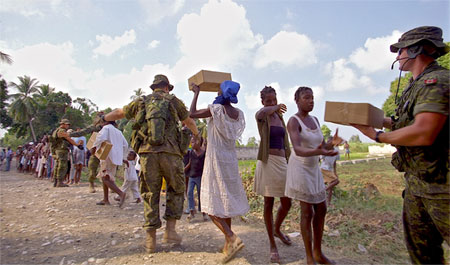Rescue plunges audiences into the hard, but inspiring work of saving lives in the face of a natural disaster. Behind the scenes, the film follows a Canadian naval commander, two pilots, and a volunteer rescue technician as they train for action. When an earthquake strikes Haiti, creating one of the biggest humanitarian disasters of the century, the audience is swept along, joining with the massive effort that brings military and civilian responders and hardware from around the world. Rescue is a journey of real-world disaster and emergency response captured (in 3D) with unprecedented scale and impact for the giant screen.

As Rescue opens we are introduced to the film’s featured personalities and are thrust into some of their remarkable training, at sea, in the air and on the ground, discovering something of their backgrounds, pastimes and motivations.
Commander Peter Crain, is the captain of a Canadian Navy destroyer (HMCS Athabaskan) — a prized assignment for the career Navy man who grew up in boats, but never learned to swim. For Crain, it’s a career that has taken him around the world, policing the seas, protecting the coastline. For Crain every day in the Navy has been an adventure.
Captain Lauren Ross, the young pilot of a U.S. Air Force C-17 Globemaster II has flown her jet around the world on a range of missions; at the controls of the giant transport aircraft she is realizing a childhood dream and following in the footsteps of her father and grandfather.
Steven Heicklen is a multi-talented concrete contractor and volunteer fireman who builds swimming pools for a living, but in responding to fires and disasters at home and abroad has discovered a new outlet for his managerial talents and his skills with concrete and heavy excavation equipment.
Major Matt Jonkey is a Chinook (CH-47) helicopter pilot from the Nevada Army National Guard, who left home and joined the army to make something of himself and never looked back. Now he trains others in the unique skills of crewing giant twin-rotor choppers and accomplishing challenging missions, like water and desert landings and high-altitude rescues of injured mountaineers.
January 12, 2010, the news is broadcast around the world: a magnitude 7.0 earthquake has stricken the populous Caribbean nation of Haiti. The quake shakes Haiti’s capital of Port au Prince and the surrounding region, collapsing or badly damaging more than a quarter of a million residences and businesses. Nobody knows how many are dead or injured. Our responders are called into action. The diverse skills of these individuals and the organizations behind them (Canadian Navy and Canadian Forces, U.S. Navy, Air Force and Air National Guard and NGOs) come together as part of a global emergency response effort. Rescue plunges audiences into the disaster zone to witness the scale of the devastation from the air and to see the unfolding work of disaster response with the Haitian people on the ground.
The voices of newscasters deliver essential details of the unfolding situation; our four personalities inject their thoughts and experiences. An animated sequence reveals the earthquake itself: a fault running through the island that slipped some 2 metres within a minute, releasing vast amounts of seismic energy.
From the air, the scale of the devastation in Port au Prince is astounding — a landscape of collapsed concrete as far as the eye can see. On the ground, the scenes are diverse and moving: desperate survivors await departure aboard an overcrowded ferry; children run to gather emergency drinking water delivered by helicopter from offshore Canadian Navy vessels. Help is arriving: international military transport trucks line the bottlenecked roads into Haiti and containers of emergency relief supplies crowd a supply depot; Canadian Forces personnel search in the rubble of a collapsed building for survivors; medical personnel tend to the wounded in makeshift hospitals; in tattered tent cities, survivors run behind arriving supply trucks; evacuees cue to board a C-17 military transport bound for Canada and; Navy personnel build shelters for orphans.
Through the chaos, the responders are saving lives and bringing hope: the responsibility is heavy, but the power to save and change lives is also huge. In the words of U.S. Air Force pilot, Captain Lauren Ross: “I’d like to think that if I was in a disaster, hurt and all alone, that someone would come to my rescue.” Speaking of the experience of his combat-trained sailors, Canadian Navy Commander Peter Crain delivers his assessment: “… helping out in places like Haiti, delivering food and water, and giving orphan children hope for the future, that’s not a bad legacy, not bad at all.”
